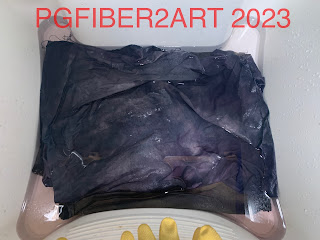Over the weekend, Virginia Consortium of Quilters (VCQ) sponsored a "slumber party" sew-along in support of the Virginia Quilt Museum. Wendy Sheppard created a pattern for one of the museum's historic quilts that is for sale on the museum website. It has been named the Harrisonburg Quilt and served as a fund raiser for the museum, which also sponsored a sew-along. You can find the pattern here.
Monday, August 21, 2023
Harrisonburg Quilt
Tuesday, August 15, 2023
DIY for Chair Arms
Sue recently got new chairs for her family room. Much to her surprise, they did not come with covers for the chair arms - the part most susceptible to wear. So she decided to try a do-it-yourself project to make some. Some fabric store remnants of cotton duck and linen-like fabric seemed suitable for attempting to dye something that might work. The last vestiges of elephant gray dye left in the jar would have to do. If it didn't work, nothing lost; just come up with another plan.
Here it is soaking in the laundry tub. You can see here it looks more gray than purple.
Here are 4 shots of different areas of the washed & dried fabric. Some areas are gray, some more blue, some purplish. Not enough dye to come out solid, but homogeneous enough to give an overall impression of gray. Sue decided it would well enough with the new gray chairs and set about crafting the arm covers.
She made rectangles long enough to cover about 5-6 inches of the front and most of the top. After clean finishing the edges, she fit each one on the chairs, folding in triangles at the corners for a snug fit. After stitching the triangles in place, they were ready. Sue is satisfied with the result. What do you think?
Monday, August 7, 2023
Altering Cyanotype Prints
This is a repost from October 2021 when we attended a Red Thread Retreat with Lesley Riley to learn more about cyanotype/botanical printing.
At the Red Thread Retreat, we enjoyed learning ways to alter our cyanotype images by using different chemicals and techniques. Serendipity is also a big part of the process. Even though you change things up from a traditional blue and white cyanotype print, you never know what you will get when you start adding other components to the experiment. There is a lot you also don't have control over such as the amount of sunshine, the humidity and the angle of the sun. You can somewhat control other additives to the botanicals placed in your design.












